Types of Helicopter Seeds (With Pictures) – Identification Guide
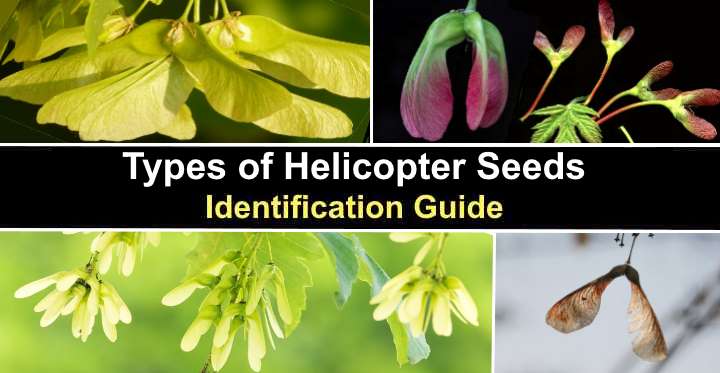
Helicopter seeds are the winged seeds of several species of deciduous trees. These papery, winged seeds are named helicopter seeds because they fall to the ground in whirling motion—just like a helicopter’s rotor blades. The primary types of trees producing helicopter seeds are maple, ash, elm, and sycamore trees. The wind can then disperse spinning helicopter seeds far from the host tree, helping the trees to flourish in a woodland landscape.
Most types of helicopter seeds are double-winged varieties. These have the two seeds joined together in the middle. These types of helicopter seeds are common with maple and ash trees. Other types of trees, like elms and hoptrees, have samaras with the seed in the center of the papery casing.
This article is a complete guide to helicopter seeds produced by several species of deciduous trees. Knowing the identifying features of various types of samaras will help you identify the species of tree they are from.
What Are Helicopter Seeds?
A helicopter seed is a dry fruit or seed in a flattened paper-tissue casing that extends to one side. Most samaras have a wing-like appearance and spin around as they fall to the ground. This “whirly” rotating action is why samaras are called helicopter seeds.
Other names for helicopter seeds are “twisters,” “whirligigs,” “spinning jenny,” and “whirlers.” Samara-producing trees sometimes release hundreds of these spinning winged seeds in strong breezes. This means that woodland understories, roofs, lawns, patios, and gutters can be filled with helicopter seeds if maple or sycamore trees are nearby.
Helicopter seeds can measure 0.78” to 3” (20 – 75 mm) long. The shape of helicopter seeds means they are ideal for floating. The long papery wing has a rounded end and veins that help the nut to rotate through the air.
Although many trees produce samaras, not all can be called “helicopter seeds.” Some samaras are round, papery casings that float on the wind without any noticeable spinning action.
The Main Types of Helicopter Seeds
The primary types of trees producing helicopter seeds are maple, ash, elm, and sycamore trees. These winged seeds typically grow in pairs and have double wings with the seeds joined at the center. However, some have a single wing that falls in a whirling motion when it drops from the tree.
Trees like elm trees and hoptrees have seeds enclosed in rounded, papery casings. Tree of heaven seeds are unusual types of “helicopter seeds” because they have a winged, twisted appearance, and the seed is in the center.
Types of Helicopter Seeds (With Identification Guide)
Let’s look in detail at types of helicopter seeds growing on maple, ash, sycamore, mahogany, and elm trees. In addition, you find information on other trees with papery, winged seeds like the tulip tree, tipu tree, and tree of heaven.
Silver Maple Seeds (Acer saccharinum)
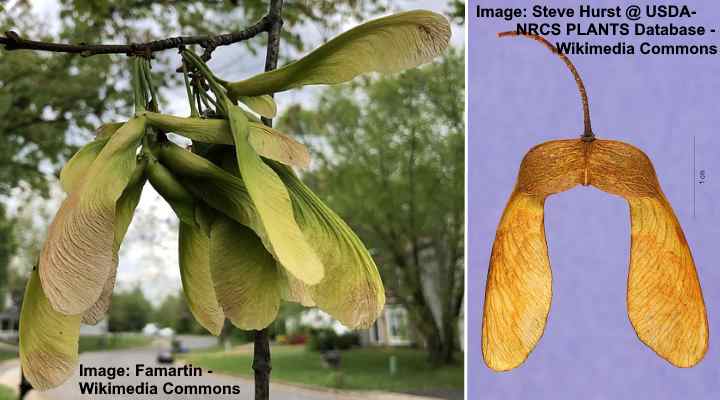
Silver maple helicopter seeds: immature seeds (left) and mature seed (right)
Silver maple trees produce helicopter seeds that measure around 3” (75 mm), making them the largest type of whirling samaras. At the immature stage, the veined papery seeds have a pale tan color with two greenish seeds joined in the middle. When mature, the helicopter seeds turn brown. The winged seeds spread at a 90° angle and grow in clusters on silver maple trees.
Silver maple trees are large shade trees with a rapid growth rate of 2 to 3 ft. (0.6 – 1 m) per year. These deciduous, cold-hardy trees grow 50 to 80 ft. (15 – 24 m) tall and with a canopy 60 ft. (18 m) wide. They thrive in USDA zones 3 through 9.
Apart from the large helicopter seeds, identifying features of silver maples are their five-lobed leaves measuring 6” (15 cm) wide that turn yellow and brown in the fall. Additionally, silver maple trees have dark gray to dark brown shaggy bark.
Norway Maple Seeds (Acer platanoides)
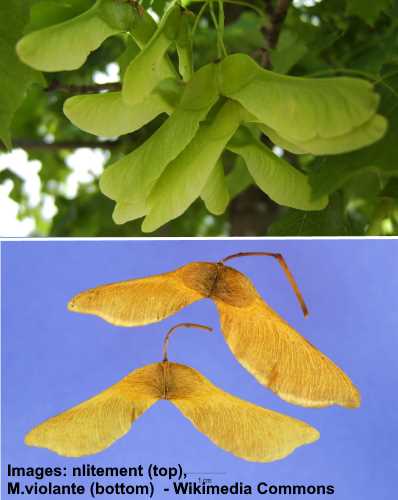
Norway maple helicopter seeds: immature seeds (top) and mature seeds (bottom)
Helicopter seeds from Norway maple trees are large, winged nuts that join at a nearly 180° angle. The whirligigs measure 1.18” to 2” (30 – 50 mm) long. The green seeds with red tinge mature in September and October and turn brown when ready to fly.
The spinning samaras hang in clusters from Norway maple tree branches before they drop and spin away in the wind. Norway maple trees measure 40 to 50 ft. (12 – 15 m) tall and wide. In fall, the deep green foliage turns a bright golden-yellow color.
In addition to the horizontally joined helicopter seeds, identifying features of the Norway maple tree are its large maple leaves with five pointed lobes and light gray bark with noticeable vertical ridges.
Red Maple Tree Seeds (Acer rubrum)
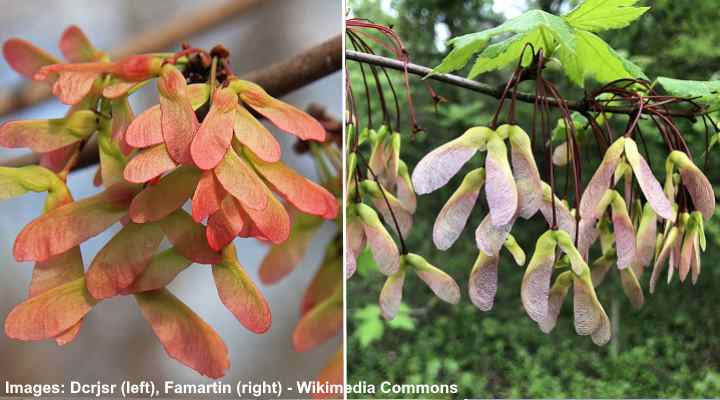
Red Maple helicopter seeds: immature seeds (left) and mature seeds (right)
Helicopter seeds of the red maple tree are attractive winged nuts with brownish-red wings and a green casing around the dry fruits. The paired wings join, forming a “V” shape, and the attractive whirlers dangle in clusters from deep red petioles. When mature, the “maple copters” turn tan or brown.
Red maple tree seeds appear in spring and summer. The seeds are smaller than other maple species—only measuring 0.75” (20 mm) long. These reddish helicopter seeds also disperse in spring before the leaves are developed. This habit is unlike “copter” seeds on the sugar maple that remain on the tree until fall.
Red maple trees are hardy in USDA zones 2 through 9. Growing in full sun or partial shade, the attractive landscape maples grow 40 to 120 ft. (12 – 36 m) and up to 50 ft. (15 m) wide. The maple’s leaves have three triangular lobes, and its trunk is light gray with vertical ridges.
Japanese Maple Seeds (Acer palmatum)
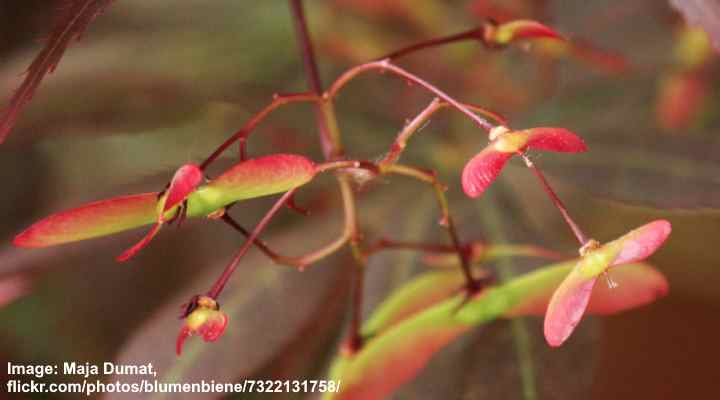
Japanese maple helicopter seeds
Ornamental helicopter seeds on Japanese maple trees are reddish-winged nuts growing in fused pairs. The pair of wings are joined, forming an arch. Unlike other types of maples, the green and red helicopter seeds grow along petioles rather than in dense clusters. They measure 0.75” to 1.25” (20 – 30 mm) long.
Japanese maple trees are small ornamental landscaping trees with spectacular palmate red leaves. The tree’s foliage consists of lobed, linear leaves with serrated margins. The purplish-red leaves turn dark burgundy, or purple in the fall.
Japanese maples grow 15 to 25 ft. (4.5 – 7.6 m) tall and wide. The small landscaping trees are ideal for planting in compact front or backyards to add a splash of red colors to residential gardens from spring through fall.
Field Maple Seeds (Acer campestre)
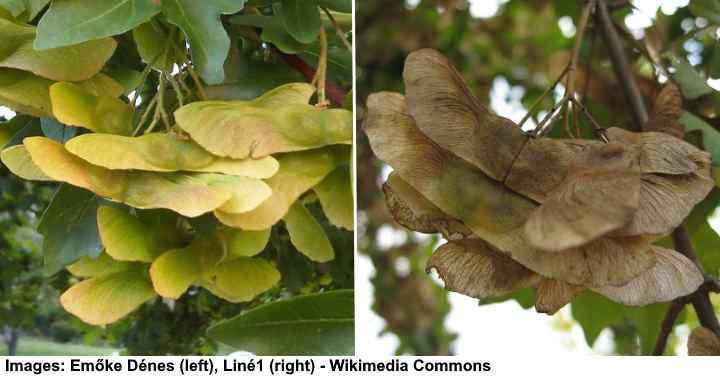
Field maple helicopter seeds: immature seeds (left) and mature seeds (right)
Field maple helicopter seeds are distinctive samaras because they are joined horizontally at the nuts. The relatively small winged seeds are green and may develop a reddish tinge. However, they turn copper or brown by fall when they are ready to twirl through the air as they are dispersed from the maple tree.
Helicopter seeds on field maple trees measure 0.75” (20 mm) long. The greenish-red horizontal wings dangle on green petioles in small clusters. Its leaves measure 4” (10 cm) wide and have three to five rounded lobes.
Field maple trees are small, ornamental trees that grow 25 to 32 ft. (7.6 – 10 m) tall. The shrub-like tree can grow as a specimen plant in a small garden, or you can plant it as a screening hedge. The sun-loving decorative tree thrives in USDA zones 5 to 8.
Sycamore Maple Seeds (Acer pseudoplatanus)
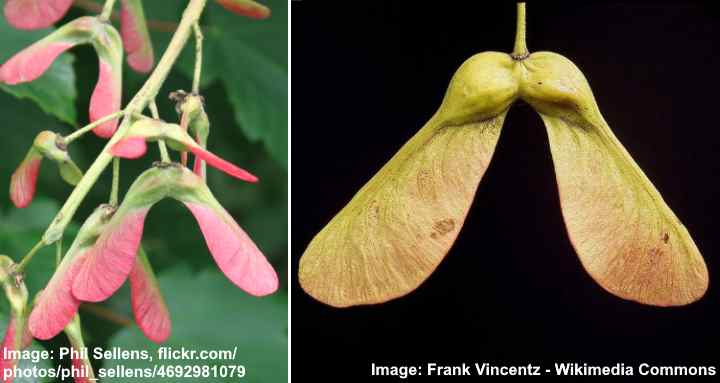
Sycamore maple helicopter seeds: immature seeds (left) and mature seed (right)
As the botanical name suggests, this “sycamore” tree is a member of the maple family Acer. The helicopter seeds of this tree species are distinctive because the pair of winged seeds join to form a “U” shape. The bright green and red samaras that turn pale brown when mature measure 2” (50 mm) long.
Also called the planetree maple, the seeds from this “sycamore” species differ from true sycamore trees. True sycamores seeds are contained in large round fuzzy balls that contain many downy-winged seeds. The seeds disperse when the round seed cases drop and split on the ground.
The sycamore maple tree is a mid-sized shade tree that grows 40 to 60 ft. (12 – 18 m) tall and 40 ft. (12 m) wide. Characteristics of this tree are its leathery green leaves with five lobes, dark orange-brown bark, and clusters of golden yellow flowers that bloom in spring.
Winged Elm Seeds (Ulmus alata)
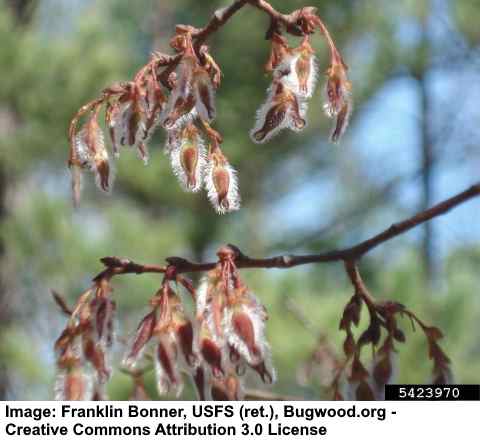
Winged elm seeds have distinctive shape and can be dispersed in the wind to great distances
Winged elm seeds are papery samaras but lack the characteristic winged shape of maple and sycamore trees. Instead, the tiny seeds are encased in a wafer-like elongated enclosure that forms an elliptical papery wing with a tip at the end. The elongated shape of these winged seeds with curving bristle at the end and fuzzy cover allows them to disperse great distances in the wind.
The elliptical winged elm seeds measure 0.33” (8.5 mm) across. The pale greenish papery disks have a slightly fuzzy covering and a pale tan margin. The winged seeds grow in large clusters on elm tree branches. They mature in late spring and float away in spring and summer breezes.
Winged elm trees thrive in USDA zones 6 to 9 and grow 40 to 60 ft. (12 – 18 m) tall. Other identifying features of elm trees are their oblong leaves with doubly toothed margins, dark gray bark, and open, pyramidal, vase-shaped crown.
Velvet Ash Seeds (Fraxinus velutina)
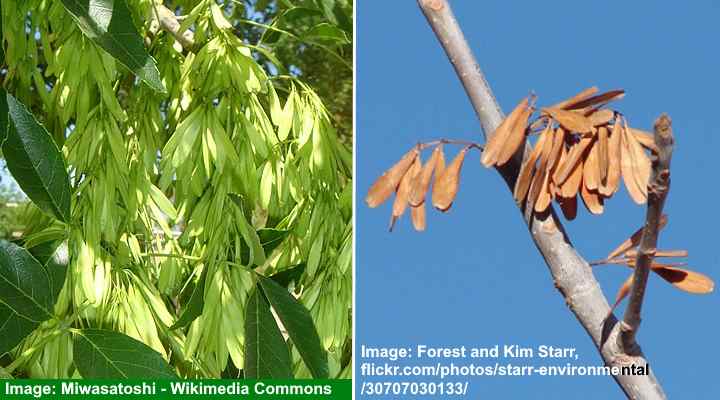
Velvet ash helicopter seeds: immature seeds (left) and mature seed (right)
Velvet ash helicopter seeds are a single-winged type of dry tree fruit that grows in huge clusters. The elongated linear seed cases measure 0.5 to 1” (13 – 25 mm). Although ash seeds don’t resemble maple seeds, they have a rotating motion as they fall from the tree and are carried by the wind.
The velvet ash tree is a fast-growing deciduous tree with a vase-shaped, spreading crown. This ash tree species grows 30 to 50 ft. (10 – 15 m) tall.
Apart from the clusters of green helicopter seeds that turn brown when mature, characteristics of the velvet ash tree are its pinnately compound leaves containing several leaflets, fissured gray-brown rough bark, and small clusters of spring flowers.
American Ash Seed (Fraxinus pennsylvanica)

American ash helicopter seeds: immature seeds (left) and mature seed (right)
Helicopter seeds from the American ash tree are single-winged flat samaras that dangle in large, voluminous clusters. The green “copter” seeds grow 1” to 2” (25 – 50 mm) long and mature to brown color from August through October. However, the dangling clusters of winged seeds can persist through winter.
American ash is a common native deciduous tree in North America. The landscape trees grow 50 to 70 ft. (15 – 21 m) tall and up to 50 ft. (15 m) wide. Characteristics of the ash tree are its irregular crown, pinnately compound leaves, and small clusters of purple flowers.
Tipu Tree Seed (Tipuana tipu)
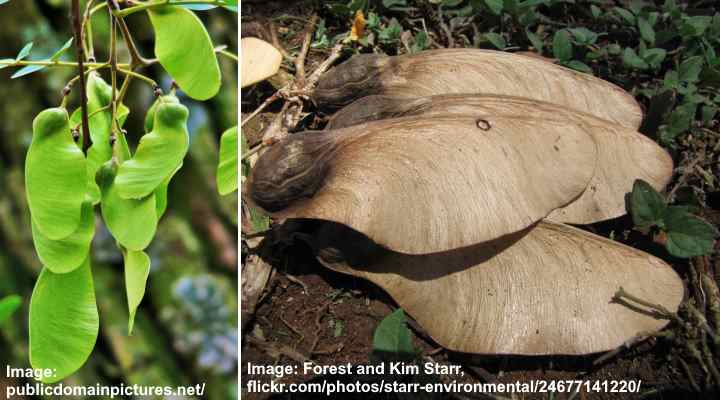
Tipu tree helicopter seeds: immature seeds (left) and mature seed (right)
The helicopter seeds from the tipu tree are large papery flattened seed casings with a single wing. The large winged seeds measure 1.5” to 2.7” (40 – 70 mm) long and dangle from the tree’s branches. The tipu “whirlers” emerge green before turning to brown.
The tipu tree is a fast-growing deciduous tree with a straight trunk, fissured bark, and long, pinnately compound leaves. The ornamental tree only grows in southern states in USDA zones 9 to 11, making it a good shade tree for Florida.
One of the attractive features of tipu trees is the stunning floral display of orange or yellow flowers that cover the tree’s canopy in the summer. In addition, hundreds of brown-cased seeds cover the ground in the fall and winter under the tree’s spreading canopy.
Tulip Tree Seed (Liriodendron tulipifera)
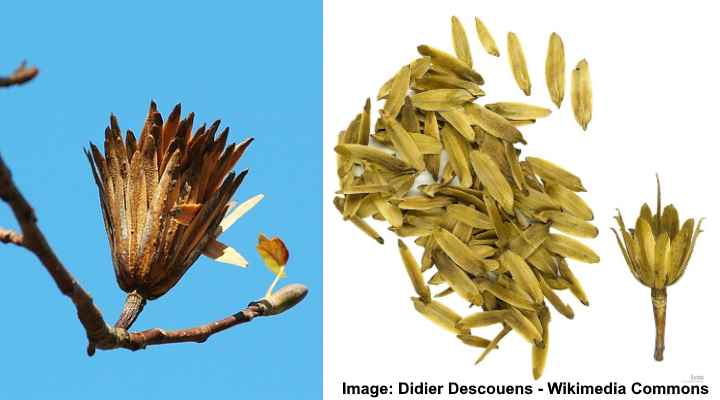
Tulip tree helicopter seeds
Tulip tree seeds are a unique feature of this spectacular flowering tree. The winged papery seeds grow together to form tan-colored cone-shaped structures that cover the tree in the fall. The pointed oblong fruits contain samaras that are 2” to 3” (50 – 75 mm) long. The cone-like fruits separate in the fall, allowing the winged seed to disperse in the wind.
In USDA zones 4 to 9, the tulip tree is an attractive ornamental tree. The decorative features of the large pyramidal tree are its stunning yellow, orange, and green tulip-like flowers measuring 2.5” (63 mm) long. A unique feature of the flowering tree is its winter buds which resemble a duck’s bill.
Tulip trees are one of the largest native deciduous trees in North America.
Common Hoptree (Ptelea trifoliata)
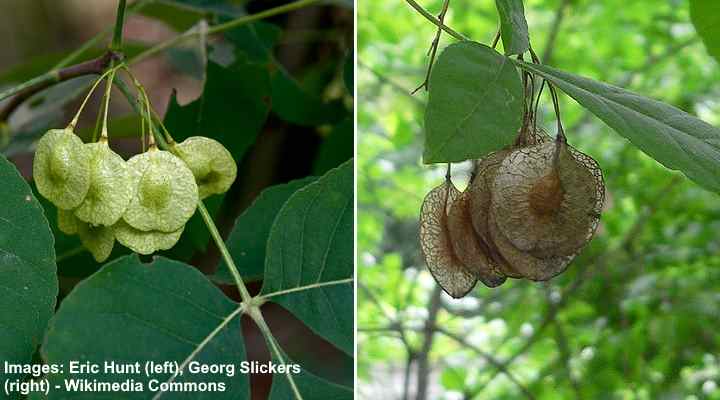
Common hoptree seeds: immature seeds (left) and mature seed (right)
The winged seeds of the common hoptree are flattened papery structures that look like the seeds of many elm trees. The thin papery circular fruits are greenish-tan and measure 1” (25 mm) wide. Each samara contains two or three seeds that appear in June and persist on the tree through winter.
Hoptree grows as a shrub or small multi-stemmed bushy tree. The identifying features of the tree are its star-shaped greenish-white flowers, lush, dark green leaves, and rounded samaras that mature to a chocolatey-brown color in late summer.
Hoptrees thrive in USDA zones 4 to 9 and perform well in shade or sun. Growing up to 20 ft. (6 m) tall, you can plant hoptrees as an informal hedge, privacy screen, specimen tree, or understory shrub.
Tree of Heaven (Ailanthus altissima)
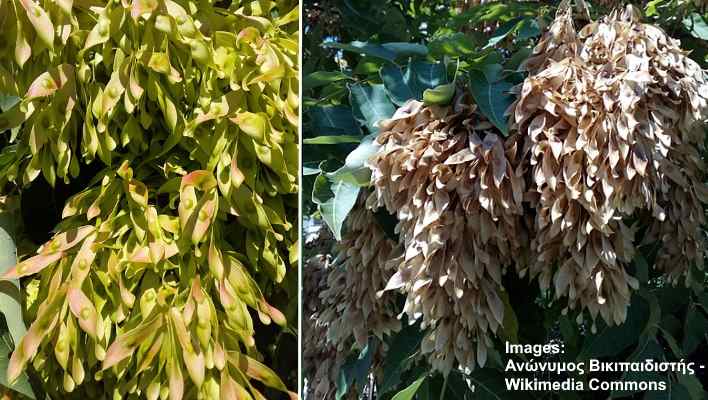
Tree of heaven helicopter seeds: immature seeds (left) and mature seed (right)
Samaras growing on the tree of heaven are large winged seeds with an oval seed in the middle of the casing. The unusual feature of these “helicopter” seeds is their twisted appearance as they grow in large drooping clusters on the tree. The samaras are green with a rosy or pale red tinge on one side and turn brown when mature.
The tree of heaven is invasive and can crowd out native trees in North America. Thriving in USDA zones 4 to 8, the aggressive trees grow 40 to 60 (12 – 18 m) tall and up to 30 ft. (10 m) wide.
Ornamental features of the non-native tree are its golden yellow drooping flower clusters measuring 7” (21 cm) long, pinnately compound leaves with up to 41 leaflets, and light gray bark.
Mahogany Trees (Swietenia)
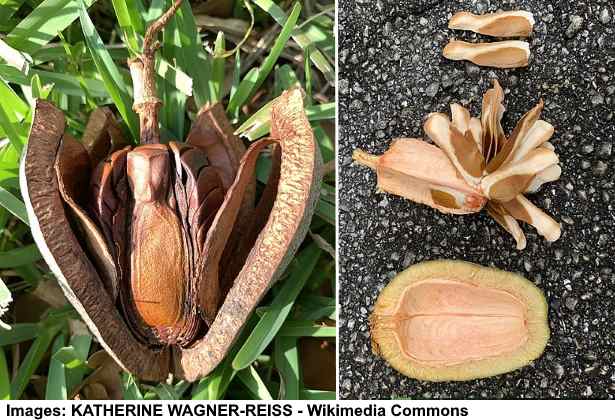
West Indian mahogany (Swietenia mahagoni)— woody capsule containing numerous winged seeds
Mahogany trees produce egg-shaped seed pods that contain numerous winged brown seeds. The hard, oval seed capsules measure 3” to 5” (75 – 127 mm) long and release the helicopter seeds when they break open on the ground.
Mahogany trees are native to South Florida, where they are popular street and landscape trees. The loose tree foliage consists of pinnately compound leaves with lance-shaped, dark green leathery leaflets. This makes mahogany trees ideal shade trees as they allow dappled sunlight to reach the ground.
Mahogany trees thrive in USDA zones 10 and 11. They grow 40 to 60 ft. (12 – 18 m) and have a spreading canopy up to 50 ft. (15 m) wide.
Related articles:
